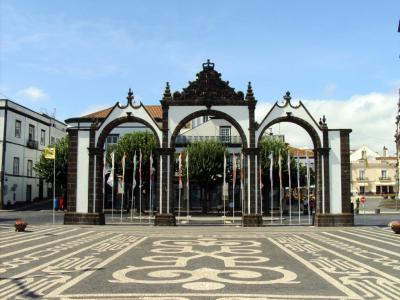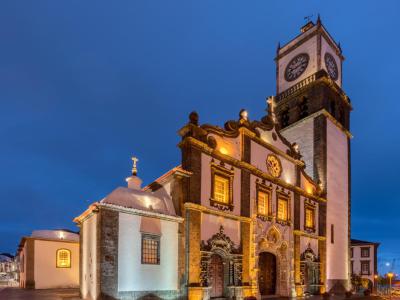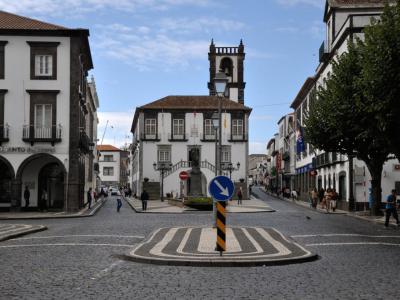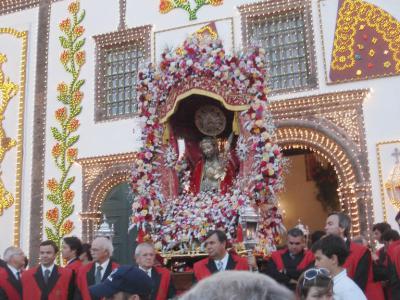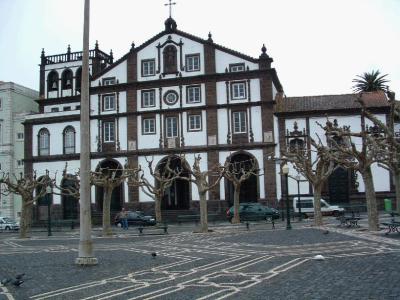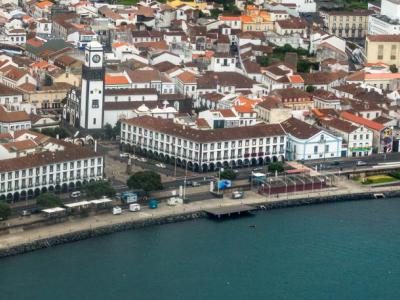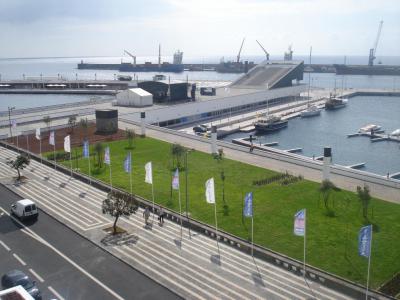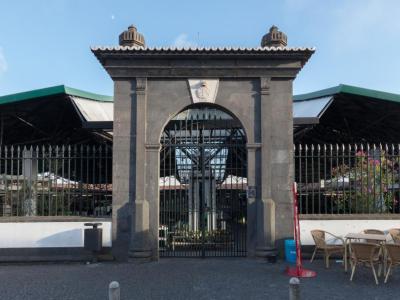Ponta Delgada Introduction Walking Tour (Self Guided), Ponta Delgada
The regional capital of the Azores archipelago, Ponta Delgada is a rewarding introduction to this remote Portuguese territory. The city lies on the south coast of São Miguel, the archipelago's largest island, and is one of the world's great adventure tourism destinations.
The Ponta Delgada name translates from Portuguese to "delicate or thin point", tracing its origins to a small fishing village, founded in 1450. The village was named so for its location on slender volcanic lands extending to the sea.
Historically, Ponta Delgada played a crucial role in Portugal's maritime expansion during the Age of Discovery. A key figure of that era, the 15th-century Portuguese navigator Gonçalo Velho Cabral, is duly commemorated by a square named in his honor, serving as a reminder of the city's connection to the exploration of new worlds.
During the 16th century, Ponta Delgada gained prominence and was elevated to city status in 1546. It played a pivotal role during the naval Battle of Ponta Delgada in 1582, defending Portuguese control of the Azores.
In the 18th and early 19th centuries, the city experienced economic prosperity, fueled by citrus exports to the United Kingdom and the growth of foreign-owned businesses, including Jewish merchants. It underwent modernization with the creation of gardens, ornate homes, and improved infrastructure.
Distinctive buildings of whitewash and black basalt lend Ponta Delgada its monochrome complexion, without detriment to its colorful character, though. As you explore the historical center, you'll encounter a plethora of cultural landmarks.
The Church of Saint Sebastian is a beautiful example of Azorean construction. The nearby City Hall and Bell Tower also add a great deal to the city's architectural charm.
You can visit the Our Lady of Hope Convent and view the venerated Holy Christ of Miracles, an important religious artifact in Azorean culture.
A stroll down Infante Dom Henrique Avenue will take you along the waterfront, where you can enjoy scenic views of the Atlantic and the iconic Gates of the Sea (Portas do Mar).
To experience the local flavors and vibrant atmosphere, visit the Grace Market (Mercado da Graça). Here, you can savor traditional Azorean cuisine and purchase local products.
Spare no time to explore these locations, and you'll discover a wealth of history, culture, and natural beauty. So, pack your bags, put on your walking shoes, and embark on an unforgettable journey to this captivating Azorean gem!
The Ponta Delgada name translates from Portuguese to "delicate or thin point", tracing its origins to a small fishing village, founded in 1450. The village was named so for its location on slender volcanic lands extending to the sea.
Historically, Ponta Delgada played a crucial role in Portugal's maritime expansion during the Age of Discovery. A key figure of that era, the 15th-century Portuguese navigator Gonçalo Velho Cabral, is duly commemorated by a square named in his honor, serving as a reminder of the city's connection to the exploration of new worlds.
During the 16th century, Ponta Delgada gained prominence and was elevated to city status in 1546. It played a pivotal role during the naval Battle of Ponta Delgada in 1582, defending Portuguese control of the Azores.
In the 18th and early 19th centuries, the city experienced economic prosperity, fueled by citrus exports to the United Kingdom and the growth of foreign-owned businesses, including Jewish merchants. It underwent modernization with the creation of gardens, ornate homes, and improved infrastructure.
Distinctive buildings of whitewash and black basalt lend Ponta Delgada its monochrome complexion, without detriment to its colorful character, though. As you explore the historical center, you'll encounter a plethora of cultural landmarks.
The Church of Saint Sebastian is a beautiful example of Azorean construction. The nearby City Hall and Bell Tower also add a great deal to the city's architectural charm.
You can visit the Our Lady of Hope Convent and view the venerated Holy Christ of Miracles, an important religious artifact in Azorean culture.
A stroll down Infante Dom Henrique Avenue will take you along the waterfront, where you can enjoy scenic views of the Atlantic and the iconic Gates of the Sea (Portas do Mar).
To experience the local flavors and vibrant atmosphere, visit the Grace Market (Mercado da Graça). Here, you can savor traditional Azorean cuisine and purchase local products.
Spare no time to explore these locations, and you'll discover a wealth of history, culture, and natural beauty. So, pack your bags, put on your walking shoes, and embark on an unforgettable journey to this captivating Azorean gem!
How it works: Download the app "GPSmyCity: Walks in 1K+ Cities" from Apple App Store or Google Play Store to your mobile phone or tablet. The app turns your mobile device into a personal tour guide and its built-in GPS navigation functions guide you from one tour stop to next. The app works offline, so no data plan is needed when traveling abroad.
Ponta Delgada Introduction Walking Tour Map
Guide Name: Ponta Delgada Introduction Walking Tour
Guide Location: Portugal » Ponta Delgada (See other walking tours in Ponta Delgada)
Guide Type: Self-guided Walking Tour (Sightseeing)
# of Attractions: 9
Tour Duration: 1 Hour(s)
Travel Distance: 2.2 Km or 1.4 Miles
Author: DanaOffice
Sight(s) Featured in This Guide:
Guide Location: Portugal » Ponta Delgada (See other walking tours in Ponta Delgada)
Guide Type: Self-guided Walking Tour (Sightseeing)
# of Attractions: 9
Tour Duration: 1 Hour(s)
Travel Distance: 2.2 Km or 1.4 Miles
Author: DanaOffice
Sight(s) Featured in This Guide:
- Gonçalo Velho Square and City Gates
- Igreja Matriz de São Sebastião (Church of Saint Sebastian)
- City Hall and Bell Tower
- Our Lady of Hope Convent and Holy Christ of Miracles
- Igreja de Sao Jose (Church of St. Joseph)
- São Brás Fort and Acores Military Museum
- Infante Dom Henrique Avenue
- Portas do Mar (Gates of the Sea)
- Mercado da Graça (Grace Market)
1) Gonçalo Velho Square and City Gates (must see)
Gonçalo Velho Square is steeped in history and serves as a gateway into the city from the sea. Today, it stands as a focal point, surrounded by an array of significant buildings and monuments, including the striking monument of Gonzalo Velho Cabral. The traditional-style buildings that line both sides of the square now house the Port Authority, adding a touch of historical significance to the area.
A key feature is the city gates, a landmark of Ponta Delgada that dates back to 1783, representing a symbol of the city. This Baroque-style construction boasts three impressive arches, each meticulously adorned with intricately carved details that showcase the royal and city’s coat of arms. The striking contrast between the white marble and black basalt in the carvings creates an impressive visual impact.
Originally located near the old pier, a few meters away, these historic gates were relocated to their present location in Praça de Gonçalo Velho in 1952. This shift was due to the construction of the splendid Avenida Infante D. Henrique. Now standing as a testament to the city’s rich history, these gates are a significant cultural and architectural gem within the Ponta Delgada landscape.
A key feature is the city gates, a landmark of Ponta Delgada that dates back to 1783, representing a symbol of the city. This Baroque-style construction boasts three impressive arches, each meticulously adorned with intricately carved details that showcase the royal and city’s coat of arms. The striking contrast between the white marble and black basalt in the carvings creates an impressive visual impact.
Originally located near the old pier, a few meters away, these historic gates were relocated to their present location in Praça de Gonçalo Velho in 1952. This shift was due to the construction of the splendid Avenida Infante D. Henrique. Now standing as a testament to the city’s rich history, these gates are a significant cultural and architectural gem within the Ponta Delgada landscape.
2) Igreja Matriz de São Sebastião (Church of Saint Sebastian)
The Church of Saint Sebastian has a history dating back to the construction of a hermitage in honor of Saint Sebastian, the city’s patron saint, erected in response to a severe plague that afflicted the area. Chronicles like those of Gaspar Frutuoso in Saudades da Terra document this event, commemorating the origins of this sacred place.
The church as it stands today is a testament to its diverse history, with the construction taking place between 1531 and 1547. Assisted by kings D. João III and D. Sebastião, the magnificent Manueline-style shutters, a true treasure of that period, remain intact. The side doors, showcasing Baroque style, are carved from the local island basalt, adding to the diverse architectural elements present in the structure.
The Church of Saint Sebastian is recognized as a Property of Public Interest, marked by a rich history evident in its architecture. Through the centuries, it has undergone various transformations, representing the transitions from Gothic to Manueline and eventually to Baroque styles. Over time, it witnessed extensive construction and notable additions, including a gilded wooden main altar adorned with striking tile panels.
Within this sacred space, the chapel of Nossa Senhora do Rosário holds particular significance. Here, Father António Vieira established devotion to the Rosary in Ponta Delgada, adding another layer of historical and spiritual importance to the church's narrative.
The church as it stands today is a testament to its diverse history, with the construction taking place between 1531 and 1547. Assisted by kings D. João III and D. Sebastião, the magnificent Manueline-style shutters, a true treasure of that period, remain intact. The side doors, showcasing Baroque style, are carved from the local island basalt, adding to the diverse architectural elements present in the structure.
The Church of Saint Sebastian is recognized as a Property of Public Interest, marked by a rich history evident in its architecture. Through the centuries, it has undergone various transformations, representing the transitions from Gothic to Manueline and eventually to Baroque styles. Over time, it witnessed extensive construction and notable additions, including a gilded wooden main altar adorned with striking tile panels.
Within this sacred space, the chapel of Nossa Senhora do Rosário holds particular significance. Here, Father António Vieira established devotion to the Rosary in Ponta Delgada, adding another layer of historical and spiritual importance to the church's narrative.
3) City Hall and Bell Tower
The Ponta Delgada City Hall stands as a 17th-century building, serving as the local municipal authority. Nestled in Praça do Municipio, this small town square adjoins the city gates and hosts various significant landmarks, including the Town Hall of Ponta Delgada and its notable Bell Tower, constructed in 1724.
In this square, visitors encounter a quaint statue, a charming fountain, and a well-kept flowerbed. At times, the municipality organizes local events here, adding a dynamic touch to the serene setting, occasionally decorated quite lavishly for special occasions.
A unique highlight of this site is the opportunity to ascend the Bell Tower. Climbing this 300-year-old tower presents a fascinating experience, seemingly transporting visitors back in time. The stone stairs, particularly the narrow spiral staircase at the tower's peak, measuring a mere 42 cm (16.5 inches) wide, add to the historical ambiance.
Arriving at the tower's top platform provides panoramic aerial views of the surroundings. While there are no safety railings at this height, the visit doesn’t feel perilous as long as one exercises caution, especially with children.
Worth noting, the entrance is free, but due to the narrow stairs and limited space at the viewing platform, only a small number of visitors can access it simultaneously. Consequently, there might be a brief wait to ascend. The climb is relatively quick and not overly strenuous, requiring just a few minutes for the entire visit.
In this square, visitors encounter a quaint statue, a charming fountain, and a well-kept flowerbed. At times, the municipality organizes local events here, adding a dynamic touch to the serene setting, occasionally decorated quite lavishly for special occasions.
A unique highlight of this site is the opportunity to ascend the Bell Tower. Climbing this 300-year-old tower presents a fascinating experience, seemingly transporting visitors back in time. The stone stairs, particularly the narrow spiral staircase at the tower's peak, measuring a mere 42 cm (16.5 inches) wide, add to the historical ambiance.
Arriving at the tower's top platform provides panoramic aerial views of the surroundings. While there are no safety railings at this height, the visit doesn’t feel perilous as long as one exercises caution, especially with children.
Worth noting, the entrance is free, but due to the narrow stairs and limited space at the viewing platform, only a small number of visitors can access it simultaneously. Consequently, there might be a brief wait to ascend. The climb is relatively quick and not overly strenuous, requiring just a few minutes for the entire visit.
4) Our Lady of Hope Convent and Holy Christ of Miracles (must see)
The Convent of Our Lady of Hope is renowned for its chapel dedicated to Holy Christ of Miracles, established through the efforts of Sister Anunciada. Initially, the image was displayed in a small altar in the low choir. The original chapel no longer exists, as a new one was commissioned and blessed on March 5, 1771, depicting a blend of baroque transitioning into rococo aesthetics. At the chapel entrance, remarkable tile panels by António de Oliveira Bernardes, from 1712, grace the walls, illustrating the Birth Steps and the Passion of Christ.
The chapel interiors feature exquisite tiles created by Real Fábrica do Rato in Lisbon, dating back to 1786-1787. Senhor Santo Cristo’s treasury holds an extensive collection of jewelry and goldsmithing embellishing the image. The multiple covers, enriched with gold and silver threads and adorned with a multitude of jewels, constitute one of the country's most significant religious treasures.
The collection showcases splendid examples of Portuguese jewelry from the latter half of the 18th century. Over time, numerous believers, members of the nobility, and even the Portuguese Crown have made donations to this impressive treasury, often fulfilling vows they made.
The Holy Christ of Miracles, a wooden sculpture crafted in the Renaissance style, is a revered piece of religious art housed in the Convent of Nossa Senhora da Esperança in Ponta Delgada. This image portrays a moment from the martyrdom of Jesus Christ, referred to as "Ecce Homo," where Christ, just scourged, stands before a crowd with bound wrists, wearing a crown of thorns and a purple cloak. The portrayal captures the contrast between the physical violence on Christ's body and the serene expression on his face, particularly in his gaze, narrated in the biblical event of Pilate's Court in Luke 23:1–25.
The veneration and festivities around the Santo Cristo dos Milagres originated from revelations received by Venerable Mother Teresa da Anunciada. These ceremonies occur in the days surrounding the fifth Sunday after Easter, culminating in a grand procession that finishes on the fifth Ascension fair.
The chapel interiors feature exquisite tiles created by Real Fábrica do Rato in Lisbon, dating back to 1786-1787. Senhor Santo Cristo’s treasury holds an extensive collection of jewelry and goldsmithing embellishing the image. The multiple covers, enriched with gold and silver threads and adorned with a multitude of jewels, constitute one of the country's most significant religious treasures.
The collection showcases splendid examples of Portuguese jewelry from the latter half of the 18th century. Over time, numerous believers, members of the nobility, and even the Portuguese Crown have made donations to this impressive treasury, often fulfilling vows they made.
The Holy Christ of Miracles, a wooden sculpture crafted in the Renaissance style, is a revered piece of religious art housed in the Convent of Nossa Senhora da Esperança in Ponta Delgada. This image portrays a moment from the martyrdom of Jesus Christ, referred to as "Ecce Homo," where Christ, just scourged, stands before a crowd with bound wrists, wearing a crown of thorns and a purple cloak. The portrayal captures the contrast between the physical violence on Christ's body and the serene expression on his face, particularly in his gaze, narrated in the biblical event of Pilate's Court in Luke 23:1–25.
The veneration and festivities around the Santo Cristo dos Milagres originated from revelations received by Venerable Mother Teresa da Anunciada. These ceremonies occur in the days surrounding the fifth Sunday after Easter, culminating in a grand procession that finishes on the fifth Ascension fair.
5) Igreja de Sao Jose (Church of St. Joseph)
The Church of Saint Joseph boasts a rich history dating back to the 16th century, when the Chapel of Nossa Senhora da Conceição graced the land, belonging to the Monastery of the Order of Saint Francis. The 16th-century structure, completed in 1544, featured an imposing facade centered around a striking portal and offered an interior with three naves, adorned with painted arches and gilded woodwork embellishing the altars.
This space was reimagined in the 18th century to host the Franciscan order in Ponta Delgada, resulting in the present-day Mannerist façade and a Baroque-dominant interior adorned with resplendent gilded carvings and tiled walls in the main altar.
Within this church's graceful walls reside an array of statues reflecting Spanish-Mexican influences. The sacristy is distinguished by its magnificent baroque rosewood furniture, a testament to the fine craftsmanship of that era. To the right of the Church, the Chapel of Nossa Senhora das Dores stands, acclaimed for its windows representing an exemplary display of São Miguel's Baroque style.
This space was reimagined in the 18th century to host the Franciscan order in Ponta Delgada, resulting in the present-day Mannerist façade and a Baroque-dominant interior adorned with resplendent gilded carvings and tiled walls in the main altar.
Within this church's graceful walls reside an array of statues reflecting Spanish-Mexican influences. The sacristy is distinguished by its magnificent baroque rosewood furniture, a testament to the fine craftsmanship of that era. To the right of the Church, the Chapel of Nossa Senhora das Dores stands, acclaimed for its windows representing an exemplary display of São Miguel's Baroque style.
6) São Brás Fort and Acores Military Museum
The São Brás Fort, also known as São Brás Castle, is a pinnacle of 16th-century military architecture. Regarded as the most formidable fortification on São Miguel Island, it was strategically constructed at the original anchorage of Ponta Delgada, primarily to shield against relentless pirate and corsair assaults common in this Atlantic region. Its historical and defensive significance earned it the classification as a Property of Public Interest in 1953.
Originally adorned with a chapel dedicated to Saint Bárbara, the fort underwent changes throughout the 20th century, seeing the demolition of its chapel and the introduction of a monument honoring the casualties of the Great War in the 1930s. Although the memorial was designed by architect Raul Lino and sculptor Diogo de Macedo, its placement within the ancient walls received critique due to its scale and lack of harmony with the surroundings.
During the tumultuous period of the Second World War, São Brás Fort underwent substantial modifications, such as the reinforcement of covers to withstand air-naval bombardment and the installation of heavy machine gun positions. It was during this time that it also functioned as the headquarters of the Military Command of the Azores. Even today, it continues to serve as the headquarters of the Military Zone of the Azores and houses a Military Museum established in 1999, highlighting its historical and strategic importance in preserving the island's heritage.
The Azores Military Museum is a compelling site that offers an immersive journey through an extensive array of movable military artifacts, shedding light on pivotal moments in Portuguese military history. Within its confines, visitors can explore the rich historical context of significant events like the First World War and the Ultramar War. This insightful exploration is facilitated by an assortment of exhibits that reflect on the impact and narratives of these crucial periods.
Its outdoor spaces, thoughtfully designed through earthworks, now offer panoramic vistas overlooking Ponta Delgada, providing views previously inaccessible to visitors. These vantage points provide an added dimension to the museum experience, allowing guests to appreciate the historical significance of the site while taking in the contemporary landscape of the city.
Originally adorned with a chapel dedicated to Saint Bárbara, the fort underwent changes throughout the 20th century, seeing the demolition of its chapel and the introduction of a monument honoring the casualties of the Great War in the 1930s. Although the memorial was designed by architect Raul Lino and sculptor Diogo de Macedo, its placement within the ancient walls received critique due to its scale and lack of harmony with the surroundings.
During the tumultuous period of the Second World War, São Brás Fort underwent substantial modifications, such as the reinforcement of covers to withstand air-naval bombardment and the installation of heavy machine gun positions. It was during this time that it also functioned as the headquarters of the Military Command of the Azores. Even today, it continues to serve as the headquarters of the Military Zone of the Azores and houses a Military Museum established in 1999, highlighting its historical and strategic importance in preserving the island's heritage.
The Azores Military Museum is a compelling site that offers an immersive journey through an extensive array of movable military artifacts, shedding light on pivotal moments in Portuguese military history. Within its confines, visitors can explore the rich historical context of significant events like the First World War and the Ultramar War. This insightful exploration is facilitated by an assortment of exhibits that reflect on the impact and narratives of these crucial periods.
Its outdoor spaces, thoughtfully designed through earthworks, now offer panoramic vistas overlooking Ponta Delgada, providing views previously inaccessible to visitors. These vantage points provide an added dimension to the museum experience, allowing guests to appreciate the historical significance of the site while taking in the contemporary landscape of the city.
7) Infante Dom Henrique Avenue
Infante Dom Henrique Avenue is a significant boulevard that winds along the stunning waterfront of Ponta Delgada. It's a lively spot offering a broad pedestrian promenade that's perfect for experiencing the city's distinct character. On the western end, the avenue borders the Fort of Sao Bras, an intriguing piece of local history that adds to the allure of the area. To the east, it boasts an array of amenities, including prominent hotels, shops, cafes, and dining spots.
Closer to the Portas do Mar shopping and dining district, you'll encounter an array of eateries, street food stands, and an extensive complex of outdoor swimming pools, including an area directly integrated into the sea. This spot is always buzzing with activity, attracting both locals and tourists, especially because of the popularity of the seawater pool.
Whether you have a few hours or several days in Ponta Delgada, the waterfront avenue is a fantastic place for a leisurely stroll, people-watching, or simply enjoying some delicious ice cream. As a bonus, if you're arriving in the city by car, this avenue is one of the best parking spots, making it convenient for visitors. Additionally, cruise ship travelers will find the terminal conveniently located at the Portas do Mar area, making it easily accessible upon arrival.
Closer to the Portas do Mar shopping and dining district, you'll encounter an array of eateries, street food stands, and an extensive complex of outdoor swimming pools, including an area directly integrated into the sea. This spot is always buzzing with activity, attracting both locals and tourists, especially because of the popularity of the seawater pool.
Whether you have a few hours or several days in Ponta Delgada, the waterfront avenue is a fantastic place for a leisurely stroll, people-watching, or simply enjoying some delicious ice cream. As a bonus, if you're arriving in the city by car, this avenue is one of the best parking spots, making it convenient for visitors. Additionally, cruise ship travelers will find the terminal conveniently located at the Portas do Mar area, making it easily accessible upon arrival.
8) Portas do Mar (Gates of the Sea)
Gates of the Sea is a monumental complex that was inaugurated in 2008, transforming the city's waterfront and enhancing its maritime surroundings. This impressive undertaking seamlessly integrates a cruise ship terminal and a marina alongside public amenities that enrich the area, featuring an array of facilities like a swimming pool, underground parking, and an amphitheater. Additionally, it hosts a commercial space that includes various restaurants and shops, catering to locals and visitors alike.
The project was envisioned and brought to life by architect Manuel Salgado. Its creation marked a significant step in modernizing and uplifting the city's seaside experience. The facility not only accommodates the docking of contemporary cruise ships but also serves as a landmark for oceanic tourism, firmly establishing the city and the island on the map of global tourist cruises.
The development has been instrumental in augmenting the tourism industry, invigorating the local economy, and elevating the quality of services and commerce available in the area. This vibrant space has become a hub for both leisure and practical amenities, offering an engaging and multifaceted experience to all who visit.
The project was envisioned and brought to life by architect Manuel Salgado. Its creation marked a significant step in modernizing and uplifting the city's seaside experience. The facility not only accommodates the docking of contemporary cruise ships but also serves as a landmark for oceanic tourism, firmly establishing the city and the island on the map of global tourist cruises.
The development has been instrumental in augmenting the tourism industry, invigorating the local economy, and elevating the quality of services and commerce available in the area. This vibrant space has become a hub for both leisure and practical amenities, offering an engaging and multifaceted experience to all who visit.
9) Mercado da Graça (Grace Market)
Grace Market, originating in the mid-19th century, was a pivotal replacement for the former trade sites for agricultural and livestock goods, like the "Mercado do Pelourinho" in Matriz’s southern part, and the "Arcades of the Fair" near Cais da Terra. This market, positioned adjacent to the Convento da Graça, was emblematic of the emerging liberal ideals in the country, aiming to establish a dignified and proper trading hub within the city.
Its construction faced multiple proposed locations by the City Council, including the desecrated Church of São José, land in Largo do Colégio, presently occupied by Jardim Antero de Quental, among others. Initiated in 1848 per the Chamber’s decree of March 16, 1847, the market development witnessed further deliberations for the establishment of a second market in São José by December 30, 1849.
A significant feature included the inauguration of a marble fountain with four spouts at the center of the market on April 4, 1852. This fountain, later relocated to Largo do Poço Velho in São Roque, arrived from Lisbon along with the Praça Velha Fountain.
This bustling covered market is a treasure trove of fresh fruits, vegetables, and an assortment of traditional liquors and local souvenirs. One of the main highlights here is the diverse selection of locally grown pineapples. Delicately packaged and ready for travel, these pineapples often come in attractive boxes that are perfect to take on the plane. However, travelers should ensure the rules regarding bringing fresh fruit from overseas are followed to avoid any issues with customs regulations in their home country.
Its construction faced multiple proposed locations by the City Council, including the desecrated Church of São José, land in Largo do Colégio, presently occupied by Jardim Antero de Quental, among others. Initiated in 1848 per the Chamber’s decree of March 16, 1847, the market development witnessed further deliberations for the establishment of a second market in São José by December 30, 1849.
A significant feature included the inauguration of a marble fountain with four spouts at the center of the market on April 4, 1852. This fountain, later relocated to Largo do Poço Velho in São Roque, arrived from Lisbon along with the Praça Velha Fountain.
This bustling covered market is a treasure trove of fresh fruits, vegetables, and an assortment of traditional liquors and local souvenirs. One of the main highlights here is the diverse selection of locally grown pineapples. Delicately packaged and ready for travel, these pineapples often come in attractive boxes that are perfect to take on the plane. However, travelers should ensure the rules regarding bringing fresh fruit from overseas are followed to avoid any issues with customs regulations in their home country.
The Most Popular Cities
/ view all



